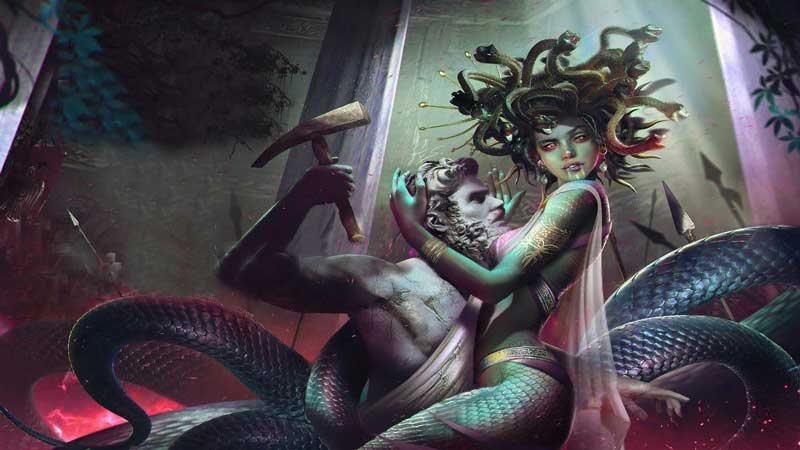
In ancient Athenian legends, Gorgon was a female monster produced by Gaea, the personification of the Earth, to help the Titans battle the gods. The Greek word Gorgon is derived from gorgos, which stands for terrible or dreadful, and probably the name was attributed to focus a vicious and deadly monster. Although the concept of the Gorgon is as old as Perseus and Zeus in classical Greek mythology, like most mythical characters, the description of Gorgon changed over time.
According to Homer, the presumed author of the Iliad and the Odyssey, Gorgon was a single monster of the Underworld. However, Hesiod, an ancient Greek poet, generally thought to have been active between 750 and 650 BC, established the more popular view of the Gorgons. According to him, there were three Gorgons, the daughters of the sea god Phorcys and his sister-wife Ceto. They were known as Stheno (the mighty), Euryale (the Far Springer), and Medusa (the Queen). Hesiod described the sisters as ugly in body and soul, and their monstrous instincts were mirrored externally by their wings, scale-covered bodies, tusks, and claws.

However, the description of the Gorgons, as provided by Ovid, a Roman poet who lived during the reign of Augustus, is completely different from that of Hesiod. In his rendition of the Gorgon myths, these three sisters were described as extremely beautiful, who tempted men to look at their faces, and who looked at their faces were immediately turned to stone.
In this version, Medusa was the only Gorgon to have live, venomous snakes for hair, resulting from being cursed by Athena (Minerva in Roman traditions) after Medusa seduced Poseidon.

In early classical art, the Gorgons were portrayed as ugly female creatures with huge wings, sharp fang, and claws. Their bodies were covered with scales, and they had round faces with horrible grins, staring eyes, and writhing snakes for hair. If anybody dared to look at them, they could immediately turn him to stone, by their uncanny terrifying gaze. They also had the power to revive the dead by blood from their right side, while blood taken from the left would instantly kill any living thing.

Much later, Medusa was depicted in art as irresistibly beautiful, but deadly. She was the only mortal among the three Gorgons. In one of the famous mythological story, the Greek hero Perseus killed and beheaded her with his sword gifted by Hermes, while protecting himself from her gaze with a polished shield gifted by Athena, which helped him to fight against the deadly monster only by looking at her reflection in the shield. When Medusa was beheaded, the winged horse Pegasus and his brother Chrysaor, a young man with his golden sword, sprang out with the flow of blood from her headless neck, her two offspring by Poseidon. As the severed head of Medusa had the power of turning all who looked upon it into stone, carved masks of the hideously grotesque head of Medusa were used in ancient days, as a protection against the evil eye.
(Ref - Medusa)
Because of their legendary and powerful gaze that could turn one to stone, images of the Gorgons often adorned the entrances to the buildings in ancient Greece and Rome and served as the protectors against outside forces. Gorgon images were also common household decorations and commonly appeared on household items like water jugs.
An image of a Gorgon was found at the pediment of the ancient temple at Corfu, which is considered the oldest stone pediment in Greece, dated around 600 BC. Apart from that, a 4`43 feet (1`35 m) tall marble statue of a Gorgon, dating from the 6th century BC, and considered to have originally belonged to a temple, was also unexpectedly discovered almost intact in 1993, in an ancient public building in Parikia, Paros capital, Greece.
